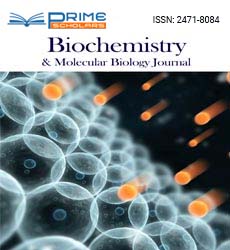Short Communication - (2024) Volume 10, Issue 6
The Mechanism of DNA Replication: A Detailed Exploration
Hei Nen*
Department of Pharmaceutics, University of Alfaisal, Saudi Arabia
*Correspondence:
Hei Nen,
Department of Pharmaceutics, University of Alfaisal,
Saudi Arabia,
Email:
Received: 02-Dec-2024, Manuscript No. IPBMBJ-25-22540 ;
Editor assigned: 04-Dec-2024, Pre QC No. IPBMBJ-25-22540 (PQ);
Reviewed: 18-Dec-2024, QC No. IPBMBJ-25-22540 ;
Revised: 23-Dec-2024, Manuscript No. IPBMBJ-25-22540 (R);
Published:
30-Dec-2024, DOI: 10.36648/2471-8084-10.6.41
Introduction
DNA replication is a fundamental biological process essential for
the transmission of genetic information from one generation to the
next. It ensures that each daughter cell receives an exact copy of
the parental DNA, preserving genetic integrity across cell divisions.
This highly coordinated process involves numerous enzymes,
regulatory factors, and distinct stages. Understanding DNA
replication is crucial for fields such as genetics, molecular biology,
and medicine, particularly in the study of genetic disorders and
cancer. The discovery of DNA as the hereditary material was made
by Oswald Avery, Colin MacLeod, and Maclyn McCarty in 1944.
However, it was the elucidation of DNAâ??s double-helix structure by
James Watson and Francis Crick in 1953 that laid the foundation
for understanding DNA replication. Their model suggested a semiconservative
mechanism, later confirmed by the Meselson-Stahl
experiment in 1958, which demonstrated that each daughter
DNA molecule consists of one original strand and one newly
synthesized strand. DNA replication follows a semi-conservative
mechanism and occurs in three main stages: initiation, elongation,
and termination. The process begins at specific sequences called
origins of replication. In prokaryotes, such as Escherichia coli,
there is a single origin known as OriC, whereas eukaryotic cells
have multiple origins to facilitate rapid replication. The origin of
replication is recognized by initiator proteins, such as DnaA in
bacteria and the Origin Recognition Complex (ORC) in eukaryotes
[1,2].
Description
Helicase enzymes (DnaB in prokaryotes and MCM complex in
eukaryotes) unwind the double helix, creating a replication fork.
Single-stranded binding (SSB) proteins stabilize the unwound
strands, preventing them from reannealing. Topoisomerases
alleviate the supercoiling tension generated during unwinding.
Once the DNA is unwound, new strands are synthesized by DNA
polymerases. DNA polymerase cannot initiate synthesis de novo;
it requires a primer. Primase, an RNA polymerase, synthesizes
short RNA primers complementary to the template strand. DNA
replication is bidirectional. The leading strand is synthesized
continuously in the 5â?? to 3â?? direction by DNA polymerase III (in
prokaryotes) or DNA polymerase ε (in eukaryotes). The lagging
strand is synthesized discontinuously in short segments called as
Okazaki fragments, using DNA polymerase δ in eukaryotes. The
RNA primers are removed by DNA polymerase I (prokaryotes) or
RNase H (eukaryotes). DNA ligase seals the gaps between Okazaki
fragments, forming a continuous strand. Replication continues
until the entire DNA molecule is duplicated. Termination occurs
at specific sequences known as Ter sites, bound by Tus proteins
to prevent further unwinding. Replication ends when replication
forks meet, or when telomeres are reached. The ends of linear
eukaryotic chromosomes, called telomeres, pose a challenge due
to the end-replication problem [3,4].
Conclusion
The enzyme telomerase extends the telomeres using an RNA
template, preventing progressive shortening and genomic
instability. Several enzymes and proteins play critical roles in DNA
replication. Unwinds the DNA double helix. Prevent premature
reannealing. Relieves supercoiling tension. Synthesizes RNA
primers. Catalyzes DNA synthesis. Joins Okazaki fragments.
Extends telomeres in eukaryotic cells. While the basic principles
of DNA replication are conserved across species, there are notable
differences between prokaryotic and eukaryotic replication. DNA
replication is tightly regulated to ensure fidelity. Key regulatory
mechanisms includes DNA replication occurs during the S-phase
of the cell cycle in eukaryotes, controlled by cyclins and cyclindependent
kinases (CDKs).
Acknowledgement
None.
Conflict Of Interest
The author declares there is no conflict of interest.
References
- Anziano RJ, Milligan PA (2021) Model informed drug development: Collaboration through a common framework. Clin Pharmacol Ther. 110(5):1165-1167.
[Crossref] [Google Scholar] [PubMed]
- Zvirblis P, Ellin RI (1976) Acute systemic toxicity of pure dimercaprol and trimercaptopropane. Toxicol Appl Pharmacol. 36(2):297-9.
[Crossref] [Google Scholar] [PubMed]
- Zhu H (2020) Big data and Artificial Intelligence modeling for drug discovery. Annu Rev Pharmacol Toxicol. 60:573-589.
[Crossref] [Google Scholar] [PubMed]
- Schmidt EW, Lin Z (2022) Translating marine symbioses toward drug development. mBio. 13(6):e0249922.
[Crossref] [Google Scholar] [PubMed]
Citation: Nen H (2024) The Mechanism of DNA Replication: A Detailed Exploration. Biochem Mol Biol J. 10:41.
Copyright: © 2024 Nen H. This is an open-access article distributed under the terms of the Creative Commons Attribution License, which permits unrestricted use, distribution, and reproduction in any medium, provided the original author and source are credited.

